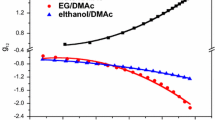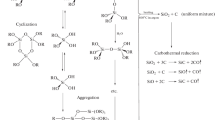Abstract
In order to investigate the effects of the non-solvent species on the formation mechanism of polyacrylonitrile (PAN) fiber in wet spinning, theoretical ternary phase diagrams of water/DMSO/PAN and ethanol/DMSO/PAN systems were constructed based on the extended Flory–Huggins theory. The cloud-points of dilute PAN solutions of the two systems were determined by titration method and those of concentrated PAN solutions from Boom’s linearized cloud-point correlation. Binary interaction parameters were calculated and optimized to construct the theoretical phase diagram. The obtained diagrams were used to investigate the effects of the non-solvent species on the formation of PAN fibers. If the non-solvent water is replaced with ethanol, the meta-stable two-phase region in the ternary phase diagram increases. This favors the de-mixing of the filament via nucleation and growth mechanism during the coagulation process, resulting in homogenous dense PAN fibers with low porosity.






Similar content being viewed by others
Abbreviations
- a, b, a 0, a 1, a 2, a 3, a 4, α:
-
Constants
- w 1 :
-
Mass fraction of non-solvent
- w 2 :
-
Mass fraction of solvent
- w 3 :
-
Mass fraction of polymer
- g 12 :
-
Concentration-dependent binary interaction parameter between non-solvent and solvent
- g 23 :
-
Binary interaction parameter between solvent and polymer
- g 13 :
-
Binary interaction parameter between non-solvent and polymer
- ΔG m :
-
Gibbs free energy of mixing
- ΔG E :
-
Excess Gibbs free energy of mixing
- n 1 :
-
Molar fraction of non-solvent
- n 2 :
-
Molar fraction of solvent
- R :
-
Gas constant
- T :
-
Absolute temperature
- Λ12, Λ21 :
-
Wilson parameter
- ϕ1 :
-
Volume fraction of non-solvent
- ϕ2 :
-
Volume fraction of solvent
- ϕ3 :
-
Volume fraction of polymer
- V 1 :
-
Molar volume of non-solvent
- V 2 :
-
Molar volume of solvent
- λ12 = λ21 :
-
Interaction energy parameter between non-solvent and solvent
- λ22 :
-
Interaction energy parameter between solvent and solvent
- λ11 :
-
Interaction energy parameter between non-solvent and non-solvent
- γ1 :
-
Activity coefficient of non-solvent
- γ2 :
-
Activity coefficient of solvent
- δ1,d :
-
Dispersion force component of the solubility parameter of non-solvent
- δ1,p :
-
Polar force component of the solubility parameter of non-solvent
- δ1,h :
-
Hydrogen bond component of the solubility parameter of non-solvent
- δ3,d :
-
Dispersion force component of the solubility parameter of polymer
- δ3,p :
-
Polar force component of the solubility parameter of polymer
- δ3,h :
-
Hydrogen bond component of the solubility parameter of polymer
- Δμ1 :
-
Difference between the chemical potential of non-solvent in the mixture and the pure state
- Δμ2 :
-
Difference between the chemical potential of solvent in the mixture and the pure state
- Δμ3 :
-
Difference between the chemical potential of polymer in the mixture and the pure state
- Δμ1,A :
-
Difference between the chemical potential of non-solvent in polymer-rich phase and the pure state
- Δμ2,A :
-
Difference between the chemical potential of solvent in polymer-rich phase and the pure state
- Δμ3,A :
-
Difference between the chemical potential of polymer in polymer-rich phase and the pure state
- Δμ1,B :
-
Difference between the chemical potential of non-solvent in polymer-poor phase and the pure state
- Δμ2,B :
-
Difference between the chemical potential of solvent in polymer-poor phase and the pure state
- Δμ3,B :
-
Difference between the chemical potential of polymer in polymer-poor phase and the pure state
- ϕ1,A :
-
Volume fraction of non-solvent in polymer-rich phase
- ϕ2,A :
-
Volume fraction of solvent in polymer-rich phase
- ϕ3,A :
-
Volume fraction of polymer in polymer-rich phase
- ϕ1,B :
-
Volume fraction of non-solvent in polymer-poor phase
- ϕ2,B :
-
Volume fraction of solvent in polymer-poor phase
- ϕ3,B :
-
Volume fraction of polymer in polymer-poor phase
- \( G_{22} \) :
-
\( \frac{{\partial^{2} \Updelta G_{\text{m}} }}{{\partial (\phi_{2} )^{2} }} \)
- \( G_{33} \) :
-
\( \frac{{\partial^{2} \Updelta G_{\text{m}} }}{{\partial (\phi_{3} )^{2} }} \)
- \( G_{23} \) :
-
\( \frac{{\partial^{2} \Updelta G_{\text{m}} }}{{\partial \phi_{2} \partial \phi_{3} }} \)
- \( G_{222} \) :
-
\( \frac{{\partial^{3} \Updelta G_{\text{m}} }}{{\partial (\phi_{2} )^{3} }} \)
- \( G_{223} \) :
-
\( \frac{{\partial^{3} \Updelta G_{\text{m}} }}{{\partial (\phi_{2} )^{2} \partial \phi_{3} }} \)
- \( G_{233} \) :
-
\( \frac{{\partial^{3} \Updelta G_{\text{m}} }}{{\partial \phi_{2} \partial (\phi_{3} )^{2} }} \)
- u 1 :
-
ϕ1/(ϕ1 + ϕ2)
- u 2 :
-
ϕ2/(ϕ1 + ϕ2)
- PAN:
-
Polyacrylonitrile
- DMSO:
-
Dimethyl sulfoxide
- LCP:
-
Linearized cloud-point
- NG:
-
Nucleation and growth
- SD:
-
Spinodal decomposition
References
Liu XD, Ruland W (1993) X-ray studies on the structure of polyacrylonitrile fibers. Macromolecules 26:3030–3036
Ogawa H, Saito K (1995) Oxidation behavior of polyacrylonitrile fibers evaluated by new stabilization index. Carbon 33:783–788
Xu Q, Xu LH, Cao WY, Wu SZ (2005) A study on the orientation structure and mechanical properties of polyacrylonitrile precursors. Polym Adv Technol 16:642–645
Arbab S, Noorpanah P, Mohammadi N, Soleimani M (2008) Designing index of void structure and tensile properties in wet-spun polyacrylonitrile (PAN) fiber. I. Effect of dope polymer or nonsolvent concentration. J Appl Polym Sci 109:3461–3469
Arbab S, Mohammadi N, Noorpanah P (2008) Designing index of void structure and tensile properties in wet-spun polyacrylonitrile (PAN) fiber. Part II: Synergistic effect of dope non-solvent concentration and jet draw ratio. Iran Polym J 17:227–235
Bogun M, Mikolajczyk T, Kurzak A, Blazewicz M, Rajzer I (2006) Influence of the as-spun draw ratio on the structure and properties of PAN fibres including montmorillonite. Fibers Text East Eur 14:13–16
Bogun M, Mikolajczyk T (2006) Influence of coagulation bath temperature on the porous structure and strength properties of PAN fibres including montmorillonite. Fibers Text East Eur 14:19–22
Dong XG, Wang CG, Chen J (2007) Study on the coagulation process of polyacrylonitrile nascent fibers during wet-spinning. Polym Bull 58:1005–1012
Zeng XM, Zhang YW, Zhao JX, Pan D (2007) Investigating the jet stretch in the wet spinning of PAN fiber. J Appl Polym Sci 106:2267–2273
Zeng XM, Chen JM, Zhao JX, Wu CX, Pan D, Pan N (2009) Investigation the jet stretch in PAN fiber dry-jet wet spinning for PAN–DMSO–H2O system. J Appl Polym Sci 114:3621–3625
Tompa H (1956) Polymer solutions. Butterworths Scientific Publications, London
Yilmaz L, McHugh AJ (1986) Analysis of nonsolvent–solvent–polymer phase diagrams and their relevance to membrane formation modeling. J Appl Polym Sci 31:997–1018
Altena FW, Smolders CA (1982) Calculation of liquid–liquid phase separation in a ternary system of a polymer in a mixture of a solvent and a nonsolvent. Macromolecules 15:1491–1497
Boom RM, Boomgaard VD, Smolders CA (1993) Linearized cloud point curve correlation for ternary systems consisting of one polymer, one solvent and one non-solvent. Polymer 34:2348–2356
Koningsveld R, Kleintjens LA (1971) Liquid–liquid phase separation in multicomponent polymer systems. X. Concentration dependence of the pair-interaction parameter in the system cyclohexane-polystyrene. Macromolecules 4:637–641
Gmehling J, Onken U (1977) Chemistry data series. Dechema, Frankfurt
Fredenslund A, Jones RL, Prausnitz JM (1975) Group-contribution estimation of activity coefficients in nonideal liquid mixtures. AIChE J 21:1086–1099
Magnussen T, Rasmussen P, Fredenslund A (1981) UNIFAC parameter table for predication of liquid–liquid equilibria. Ind Eng Chem Process Des Dev 20:331–339
Noack K, Kiefer J, Leipertz A (2010) Concentration-dependent hydrogen-bonding effects on the dimethyl sulfoxide vibrational structure in the presence of water, methanol, and ethanol. ChemPhysChem 11:630–637
Fuoss RM, Mead DJ (1943) Osmotic pressures of polyvinyl chloride solutions by a dynamic method. J Phys Chem 47:59–70
Zeman L, Tkacik G (1988) Thermodynamic analysis of a membrane-forming system water/N-methyl-2-pyrrolidone/polyethersulfone. J Membr Sci 36:119–140
Wypych G (2002) Solvent manual. China Petrochemical Industry, Bei**g
Dong RJ, Keuser M, Zeng XM, Zhao JX, Zhang YW, Wu CX, Pan D (2008) Viscometric measurement of the thermodynamics of PAN terpolymer/DMSO/water system and effect of fiber-forming conditions on the morphology of PAN precursor. J Polym Sci B 46:1997–2011
Kok CM, Rudin A (1981) Prediction of osmotic pressures of polymer solutions. J Appl Polym Sci 26:3575–3582
Qian JW, Rudin A (1992) Prediction of thermodynamic properties of polymer solutions. Eur Polym J 28:725–732
Tan LJ, Pan D, Pan N (2008) Thermodynamic study of a water-dimethylformamide-polyacrylonitrile ternary system. J Appl Polym Sci 110:3439–3447
Dong RJ, Zhao JX, Zhang YW, Pan D (2008) Morphology control of polyacrylonitrle(PAN) fibers by phase separation technique. J Polym Sci B 47:261–275
Lindvig T, Michelsen ML, Kontogeorgis GM (2002) A Flory–Huggins model based on the Hansen solubility parameters. Fluid Phase Equilibr 203:247–260
Hansen CM (2007) Hansen solubility parameters: a user’s handbook, 2nd edn. CRC Press, New York, NY
Zhang WX, Liu J, Wu G (2003) Evolution of structure and properties of PAN precursors during their conversion to carbon fibers. Carbon 41:2805–2812
Acknowledgments
The authors gratefully acknowledge the financial support from the Science and Technology Commission of Shanghai Municipality (07QA14001) and National 973 Project (2006CB605302 and 2006CB605303).
Author information
Authors and Affiliations
Corresponding authors
Rights and permissions
About this article
Cite this article
Zhang, J., Zhang, Y. & Zhao, J. Thermodynamic study of non-solvent/dimethyl sulfoxide/polyacrylonitrile ternary systems: effects of the non-solvent species. Polym. Bull. 67, 1073–1089 (2011). https://doi.org/10.1007/s00289-011-0525-9
Received:
Revised:
Accepted:
Published:
Issue Date:
DOI: https://doi.org/10.1007/s00289-011-0525-9




